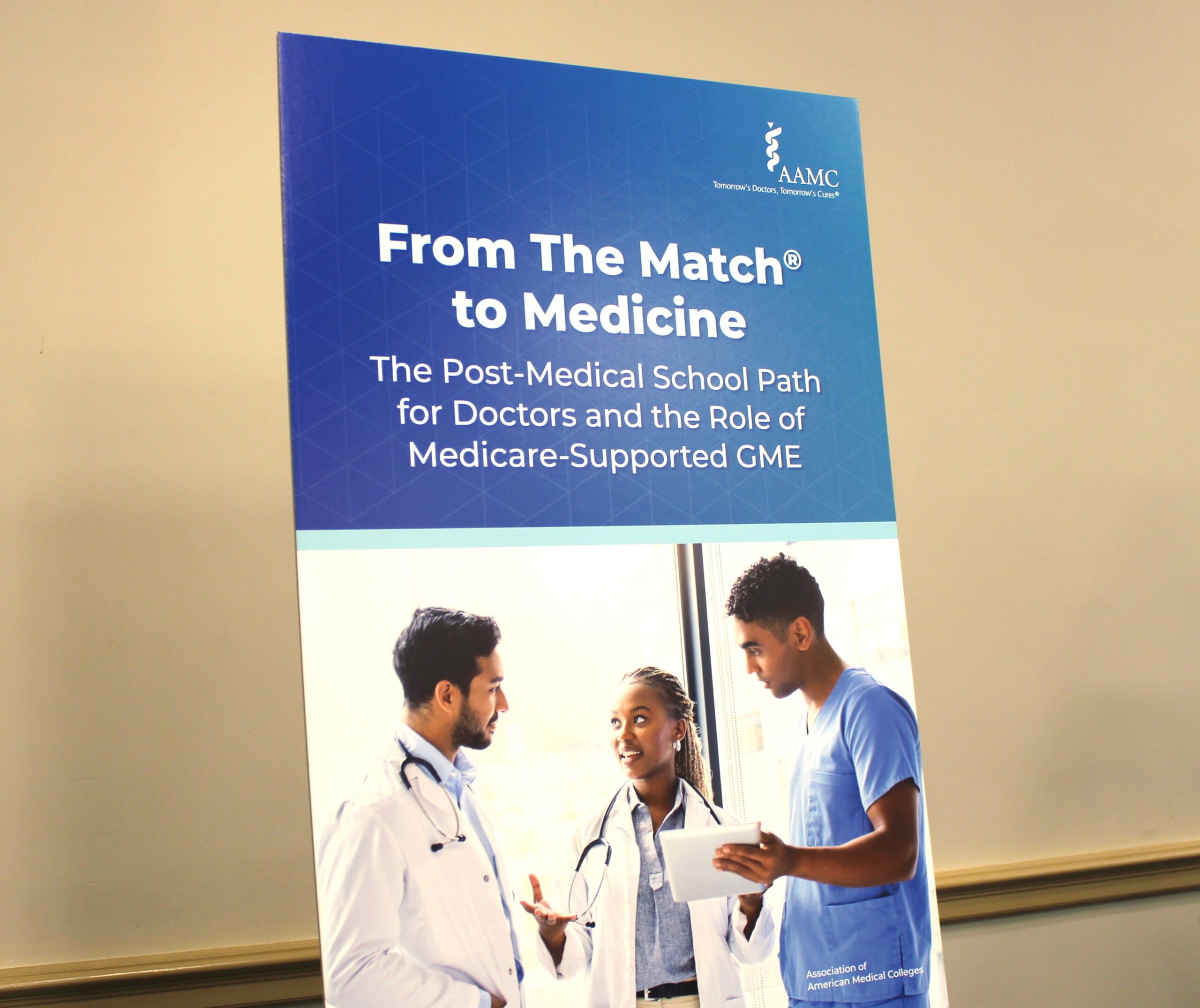As the United States faces a projected shortage of up to 124,000 physicians by 2034, training the next generation of doctors has never been more vital.
On May 9, 2023, the AAMC conducted a congressional briefing on Capitol Hill to discuss The Match®️ process, Medicare’s role in supporting graduate medical education (GME), and efforts to mitigate the physician shortage and support patients’ and communities’ access to care.

“From The Match®️ to Medicine: The Post-Medical School Path for Doctors, and the Role of Medicare-Supported GME” was held in cooperation with the Congressional Academic Medicine Caucus (CAMC), a bipartisan group co-chaired by Reps. Greg Murphy, M.D. (R-N.C.) and Kathy Castor (D-Fla.) that promotes and recognizes the importance of medical schools, teaching hospitals, and faculty physicians.
Speakers at the event included:
- Danielle Turnipseed, JD, MHSA, MPP–Chief Public Policy Officer at the AAMC
- Geoffrey H. Young, PhD–Senior Director, Transforming the Health Care Workforce at the AAMC
- Atul Grover, MD, PhD–Executive Director of the AAMC Research and Action Institute
- Catherine M. Kuhn, MD–Associate Dean for Graduate Medical Education at Duke Health
- Len Marquez–Senior Director, Government Relations and Legislative Advocacy at the AAMC

Ms. Turnipseed kicked off the event by urging House of Representatives staff in attendance to encourage their members to join the CAMC. By joining the caucus, federal lawmakers are signaling their support for the nation’s medical schools and teaching hospitals and health systems and their commitment to ensuring the U.S. has enough physicians now and for generations to come.
Keep reading for key takeaways from the event and how you can take action to ensure Congress increases the number of Medicare-supported medical residency positions nationwide.
How Graduate Medical Education Works
AAMC Action continues to advocate for additional Medicare-supported GME positions to improve the health of people everywhere, but how does GME really work?
GME is defined as post-medical school physician training that primarily occurs in a teaching hospital. As part of their teaching mission, teaching hospitals incur additional costs that other hospitals don’t, like residents’ stipends and benefits, faculty time, and residency program overhead. Since the Medicare program was established in 1965, it has provided support to help off set its share of these increased costs.
While the costs of resident training are primarily covered by teaching hospitals themselves, Medicare is the single, largest public funder of GME. Unfortunately, due to a cap placed on Medicare support for GME as part of the Balanced Budget Act of 1997 (BBA), the number of Medicare-supported training positions had been effectively frozen for over two decades.
“The era of physician surplus is over.”
– Atul Grover, MD, PhD
Executive Director of the AAMC Research and Action Institute
The Impact of Graduate Medical Education
Increasing Medicare-support for GME is one part of a multi-pronged solution to alleviating the physician shortage. Increasing the number of Medicare-supported GME positions available allows teaching hospitals to increase the size of existing programs or start new programs. Additionally, it would help increase and promote access to care for rural and other underserved communities.

Dr. Kuhn of Duke Health provided the institutional perspective and detailed how Medicare-supported GME allows her teaching hospital to advance its unique training programs for future physicians. And though Duke Health is seeing incredible interest in its residency programs, nearly 600 of these physicians are being trained over the hospital’s Medicare GME cap and receive no federal support.
Medicare-supported GME positions allow Duke Health’s residents to train in counties across North Carolina, including rural areas where physicians from underserved backgrounds can connect with underserved communities.
Over the past several years, Congress has made historic bipartisan investment and increased Medicare-supported GME. However, while this work is greatly appreciated, more needs to be done to meet the growing demand for health care services.
Strengthening the Physician Workforce
The country’s population continues to grow and age, requiring more medical care, and an aging physician workforce is nearing retirement, which creates a critical need to educate and train more doctors to help ensure there are enough physicians to care for patients and communities nationwide.
Champions of academic medicine in both chambers of Congress have recently introduced bipartisan legislation that would gradually increase the number of Medicare-supported graduate medical education (GME) positions by 14,000 over seven years.
Members of the AAMC Action community can urge their legislators to cosponsor the Resident Physician Shortage Reduction Act (S. 1302/H.R. 2389) to help strengthen and diversify the health care workforce, ensure patient access to care, and prepare for the next public health crisis.
Visit the AAMC’s website to learn more about efforts to expand GME.